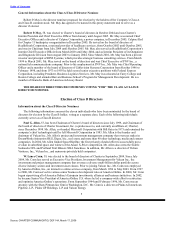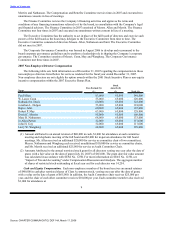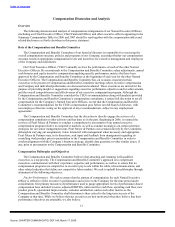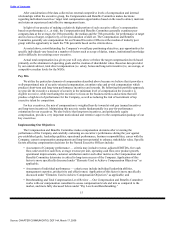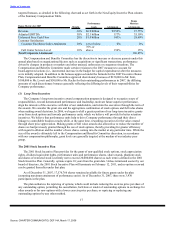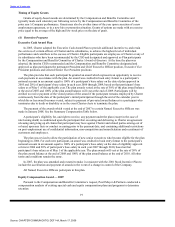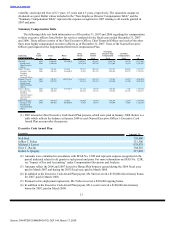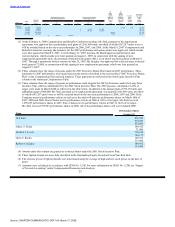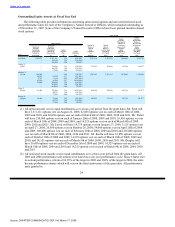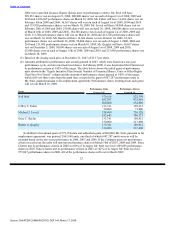Charter 2008 Annual Report Download - page 22
Download and view the complete annual report
Please find page 22 of the 2008 Charter annual report below. You can navigate through the pages in the report by either clicking on the pages listed below, or by using the keyword search tool below to find specific information within the annual report.
Table of Contents
After consideration of the data collected on external competitive levels of compensation and internal
relationships within the executive group, the Compensation and Benefits Committee makes decisions
regarding individual executives’ target total compensation opportunities based on the need to attract, motivate
and retain an experienced and effective management team.
In light of our practice of making a relatively high portion of each executive officer’s compensation
based on performance (i.e., at risk), the Compensation and Benefits Committee generally examines peer
company data at the average, the 25th percentile, the median and the 75th percentile, for performance at target
and in excess of target, respectively, or for specialization of skill set. The Compensation and Benefits
Committee generally sets compensation for our Named Executive Officers at the median of industry peer
group with the opportunity to reach the 75th percentile based on the criteria above.
As noted above, notwithstanding the Company’s overall pay positioning objectives, pay opportunities for
specific individuals vary based on a number of factors such as scope of duties, tenure, institutional knowledge
and/or difficulty in recruiting a new executive.
Actual total compensation in a given year will vary above or below the target compensation levels based
primarily on the attainment of operating goals and the creation of shareholder value. Based on data provided
by our outside advisor, total direct compensation (i.e. salary, bonus and long-term incentive) is, on average, at
competitive median levels for the NEOs.
Pay Mix
We utilize the particular elements of compensation described above because we believe that it provides a
well-proportioned mix of security-oriented compensation, retention value and at-risk compensation which
produces short-term and long-term performance incentives and rewards. By following this portfolio approach,
we provide the executive a measure of security in the minimum level of compensation the executive is
eligible to receive, while motivating the executive to focus on the business metrics and actions that will
produce a high level of performance for the Company, as well as reducing the risk of recruitment of top
executive talent by competitors.
For key executives, the mix of compensation is weighted heavily toward at-risk pay (annual incentives
and long-term incentives). Maintaining this pay mix results fundamentally in a pay-for-performance
orientation for our executives. We also believe that long-term incentives, and particularly equity
compensation, provide a very important motivational and retentive aspect to the compensation package of our
key executives.
Implementing Our Objectives
The Compensation and Benefits Committee makes compensation decisions after reviewing the
performance of the Company and carefully evaluating an executive’s performance during the year against
pre-established goals, leadership qualities, operational performance, business responsibilities, career with the
Company, current compensation arrangements and long-term potential to enhance stakeholder value. Specific
factors affecting compensation decisions for the Named Executive Officers include:
• Assessment of Company performance — criteria may include revenue, adjusted EBITDA, free cash
flow, unlevered free cash flow, average revenue per unit, operating cash flow, new product growth,
operational improvements, customer satisfaction and/or such other metrics as the Compensation and
Benefits Committee determine is critical to long-term success of the Company. Application of this
factor is more specifically discussed under “Elements Used to Achieve Compensation Objectives” as
applicable;
• Assessment of individual performance — criteria may include individual leadership abilities,
management expertise, productivity and effectiveness. Application of this factor is more specifically
discussed under “Elements Used to Achieve Compensation Objectives” as applicable; and
• Benchmarking and Total Compensation Level Review — Our Compensation and Benefits Committee
works with our compensation consultant to assess compensation levels and mix as compared to the
market, and more fully discussed below under “Pay Levels and Benchmarking.”
15
Source: CHARTER COMMUNICATIO, DEF 14A, March 17, 2008


